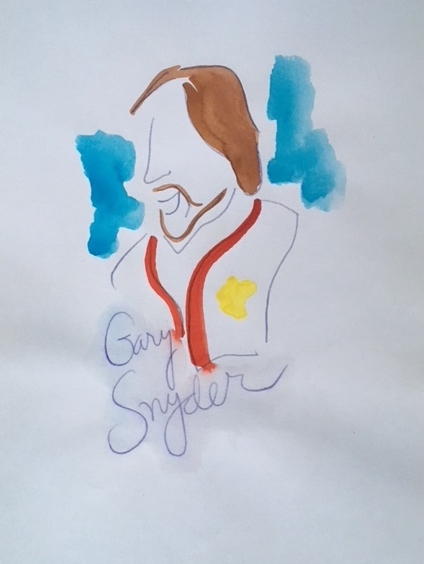For his birthday week (89 years old), I’m reposting this 2018 piece from my blog about Gary Snyder’s visit to Harvard University in Cambridge, Mass., on November 10, 1990. He read his poems and talked about writing and other subjects at Boylston Hall. The following composition captures the setting and some of his comments from that night. It was the second time I had attended a reading by Snyder, the first being at Phillips Academy in Andover, Mass., some years before. Snyder was a leading figure in poetry for me going back to the 1970s when I became serious about writing. His early book Riprap and Cold Mountain Poems influenced my work. His essays are as important to me as the poems. The event at Harvard marked the release of a collection of essays, The Practice of the Wild. Of particular interest to me is Snyder’s stance in relation to the various communities with which he connects, whether immediate neighbors, sympathetic readers, activists aligned with his environmental views, or other networks. His advice about putting a stake down and getting involved in the community of your choice reinforced my instinctive feeling that local engagement is essential. This prose sketch was published in Beat Scene magazine in England in 1991 and had not been reprinted until its appearance on the blog. The portrait is a watercolor from the late 1970s , which I failed to date specifically. I made a series of illustrations of poets I was reading at the time. I don’t know why he has no eyes here.
Gary Snyder: Remembering What He Read
RAIN-WHIPPED NIGHT OUTSIDE nondescript auditorium, school hall plain to hold wild ideas, maybe. Slowly building crowd reaches some 100 — students, Cantabrigians, academic scruffs, a few small kids, casual country-style dressers shaking off the wet. Someone tells me Snyder asked to make an appearance, saying, “He used to be a hanger-on here years ago,” but I can’t figure the logic of that since he’s from the west. This fall, he’s teaching a stint just south at Trinity College in Hartford, Connecticut. The Grolier poetry chapel has a book table in back. Microphone test next, and then, what’s this?, a video disc player is brought in.
Huge man in plaid shirt overfills a front seat. Two croissant-eating youngsters with blonde mom reading a college paper take seats to my right. Young woman behind me describes a film about the Berlin Wall. Many Snyderish men with beards, ponytails, work clothes. Another woman reading Ovid. Someone with stacks of books expecting GS to sign. A few veteran professors in the young-trending audience. Raincoats bejeweled with drops. A host of earth-colored sweaters. Cups of yogurt and steamy coffee. Umbrellas and ponchos shaken. Two black wooden chairs at a fold-up table on stage. Tech director in his booth drinks from a quart of orange juice.
This event celebrates the publication of an essay collection, The Practice of the Wild, and re-issue of Riprap and Cold Mountain Poems by North Point Press of San Francisco, those lovely, flinty old poems that made such a difference long ago. GS starts reading “Mid-August at Sourdough Mountain Lookout,” ends “Looking down for miles/Through high still air.” Then he tells on himself: “There’s something not true in this poem—’I cannot remember things I once read’”— he admits, “I could remember Chinese poems. Maybe the truth is I can’t forget anything I’ve ever read.” Follows with “Piute Creek” with “All the junk that goes with being human”—”I was working for the National Park Service at the time.”
He picks up the essays, ten years of work. “How do we resolve the dichotomy of civilization and the wild?”— “What we call wild is very orderly.” He reads calmly with witty intonations. The audience wants to laugh and chuckle, they are so happy to be in the room with him. “We have made a lot of this place, but the fishing is no good anymore,” a car dealer in California told him.
On stage GS is a small-framed man with gray-brown hair and a short gray beard wearing a blue cotton shirt open at the neck under a charcoal-gray sport coat. He says, “Very bold people from the ‘60s are still in play. Everybody’s heart was in the right place.” To the guaranteed-to-be-asked question about Jack Kerouac, he replies: “Part of his problem was alcohol . . . He looked to the past but was not necessarily reactionary. He was charming in his way.” And on being the model for Japhy Ryder, he reminds us: The Dharma Bums is a novel. “I like The Subterraneans better than The Dharma Bums, and Doctor Sax is my favorite Kerouac novel.” GS recalls climbing the Matterhorn again—”Range after range of mountains/Year after year/I am still in love.”
Why do you write?, he’s asked. “It helps me organize my own thoughts. It’s a way to participate in your community. I never thought of writing as a solitary activity. I always considered it a dialogue.” To another questioner, he responds, “You have to be a working-class person to read a lot.” He talks about community work, political work, cultural work. He says his plan for the next seven years is to finish many writing projects. “Everyone is busy. Why? They’re trying to keep up with things.” And near the close says lightheartedly, “My daily life is like everyone else’s.”
—-Paul Marion (c) 1990, 2019
